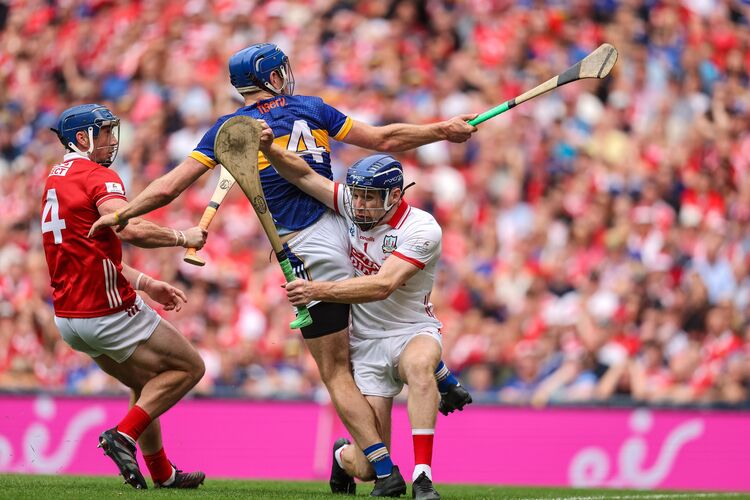The Chieftains.
By Colleen Taylor
Retirement is not a concept Paddy Moloney seems willing to accept—in mind or in elbows. Still playing, still recording, still touring, the uileann piping legend and Chieftains figurehead is somehow, remarkably, impossibly, still at it. At 81 years of age, he is currently leading the Chieftains on another American tour for their 58th year of performing. The facts in the previous sentence may look fictitious, but my recent chat with the Irish music legend evinced their verity.
Moloney’s energy projects out of him, through his voice, laughter, easy disposition, talking a mile a minute. A simple few minutes with the man will tell you he is, as his career documents, something of a superhuman. He may not go partying with the Rolling Stones till 3 in the morning anymore, but he still puts on as stellar a show as he did in the Chieftains' early years. And 2020 is no exception.
Even after 58 years, Moloney sees each show as unique, different, a “one-off,” as he puts it. Each gig on the tour, from New York’s Town Hall to the Disney Concert Hall in Los Angeles to Boston Symphony Hall, is its own specialized experience, particular to the city, its Chieftains fans—or “friends,” as Paddy would call them—and its local pipe bands and dancers. Moloney continues his grandfatherly practice of inviting all kinds of local performers into his show, including dancers, often provided by step dance teacher and legend Donny Golden, to local groups. In fact, much like Chieftain’s innovative recording history, which has always crossed traditional Irish music with other national genres, fixtures on the tour now extend well beyond Ireland. For instance, some of Paddy’s stars include the brother team Jon and Nathan Pilatzke, who demonstrate the energetic Ottawa Valley style of dancing for enthusiastic audiences.
Most interesting from my perspective is how the Chieftain’s lineup has increasingly become more female-dominated than ever before, suggesting new gender dynamics in the growth of Irish music. Moloney says that dancer Cara Butler and fiddler Tara Breen, who have both been with the tour for several years, take good care of all the performers and crew and keep the show running. There’s also the young Tríona Marshall, a new addition who plays harp for the Chieftains. Aylth McCormack is a Scots-Gaelic singer who also adds dynamic scope to the show.

Paddy Moloney.
For those who have watched the Chieftains through it all, from the early days in the 1960s and ‘70s to the breakthrough album “Long Black Veil” in 1995, the Grammy noms and wins, and years upon years of tours and collaborations, this tour will not disappoint. In addition to new young voices and influences in Irish, Scottish, Canadian, and American music, the show also reminisces on the Chieftains greatest moments. “We’re going to give a flavor of the 50 albums we’ve made over the 58 years in the tour. We open the concert with a montage of people that we have played with and people we have met,” Moloney explained. The show will feature the “Troublemaker’s Jig” he composed for Nelson Mandela, for instance, as well as “Bonaparte’s Retreat,” and some sean-nós dancing sets that bring Paddy back to his childhood, dancing parlor room sets in his grandmother’s house in the Laois mountains.
Paddy Moloney is so friendly, so familiar, and so humble that it’s sometimes easy to forget that he is also a living, breathing archive of music history. The details he can recall about his adventures, his travels, and the people he has met are as good as any history book documenting Rock N’Roll or the Folk music revolution. For instance, in the midst of our friendly chat, he recalled, offhandedly, a party at Elton John’s house, where he and Paul McCartney did a bit of Irish dancing for a laugh.
Needless to say, I had a bit of trouble regaining my composure for a follow-up question. But Paddy, ever the gentleman and pro, filled my silence with more historically-weighty memories: “You know,” he said, “I met up with Paul McCartney the day John Lennon died.” Then there’s the fact that he and Sean Keane played on Mick Jagger’s first solo album. And of course, one cannot forget that the Chieftains have won six grammys, which Paddy was also somehow and genuinely nonchalant about: “They’re lying about here somewhere.” In fact, perhaps unbeknownst to Paddy, one of them is behind the bar at Matt Molloy’s pub in Westport, Mayo, if you would like to see it for yourself. You can even ask the bartender to hold it, as I did.
In addition to being a historical archive, Paddy Moloney is a cultural ambassador. He has traveled all over the world, brought Irish music to far-off and unexpected places like Japan, where he inspired an entire subculture of uileann pipe playing, including a young, all-female Japanese traditional band called “The Lady Chieftains.” Paddy collaborated with Japanese singer Akiko Yano for the whimsically-titled tune “Saki in the Jar.” In addition, Paddy Moloney has recently received the equivalency of a knighthood from the King of Spain, awarded the Encomienda de la Orden del Mérito Civil for his contribution to traditional music worldwide.
Indeed, “Chieftains” is no longer an eight-man band formed in the 1960s but a movement—a group and family that reaches across the globe and invites disparate musicians into its circle. There are far more Chieftains now than Moloney, Sean Keane, Matt Molloy and Derek Bell. Nowadays, you can find honorary Chieftains in Spain, in Canada, in Japan, and of course, all across America. “Once you get in the tour,” Paddy joked, “well, we never say no to anybody who plays with us.” This rule may even apply to audience members who get up and dance during the show, and certainly to the New York pipers who, in years past, have taken the music from the stage in the Town Hall, out onto the streets of New York.
Still, 58 years on and off the road is an exhausting endeavor. The stress and hassle of touring and traveling has become more of a challenge to the well-seasoned Chieftains of late. (Apparently many of the other original Chieftains blame Paddy for the ever-postponed retirement: “This is your fault,” they tell him, to which he laughs.) But despite the difficulty, they won’t be denied the joy of performing, which remains a life-force. “To be playing this particular tour now is going to be a joy,” Paddy said. Moloney has a particular fondness for playing New York City’s Town Hall: “It has something magic about it, the people are almost in your parlor back home, you know. It has that homely feel.”
Toward the end of our long, cheerful, and for me, nourishing conversation, I returned to the question with which I began, still grappling for explanation. Still flabbergasted, I asked Paddy how he still does it—does he not want to retire? His answer, true to form, was a good-humored, evasive laugh. His wife jokes that he has been practicing retirement for the past 10 years. Well, no offense meant to you, Paddy, but you’re failing superbly at it. Even when he claims travel fatigue, Paddy does not seem interested in gaining more retirement practice anytime soon. He has plans for collaborating with new artists, maybe another documentary with RTE, or even more albums. But right now, even as you read this, Paddy Moloney’s thoughts and energy are with his tour, his many Chieftains, and his many friends/fans.
Don’t miss your chance to see the legend himself, live, this March. The Chieftains’ ironically (misleadingly?) titled “Irish Goodbye Tour” will reach Boston Symphony Hall on March 13, Storrs, Conn., March 14, the New Jersey Performing Arts Center in Newark on March 15, and as ever, dictated by tradition and St. Patrick himself, the Chieftains will play the New York Town Hall on 43rd Street on March 17.







